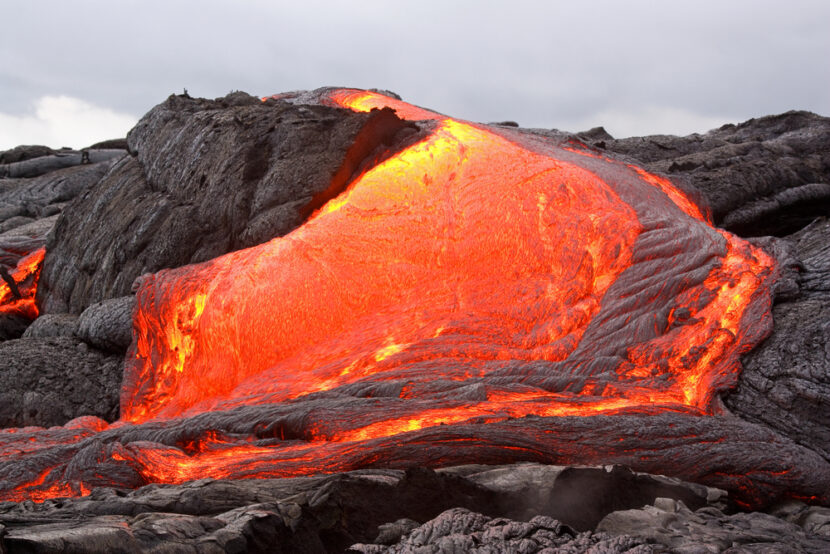HONOLULU – Lava from one of the world’s most active volcanos is creeping slowly but steadily through cracks in the earth toward a rural subdivision on Hawaii’s Big Island. Scientists warn that if the lava flow from Kilauea continues on its path, it could reach a small patch of homes in about a week.
Here’s a look at Kilauea, which has been continuously erupting since 1983:
THE LATEST
Lava could reach the Kaohe Homesteads, a sparsely populated subdivision, in four to six days after new vents on the volcano’s northeast flank were spotted June 27. Lava has been flowing underground, filling cracks and then reappearing above ground farther down the flank.
The lava has flowed about 8.2 miles from the vent, coming within a mile of the eastern edge of the Wao Kele o Puna Forest Reserve. Officials estimate with the lava moving about 820 feet a day, it could reach homes sometime next week – if it continues flowing within the crack system.
While Hawaii County Civil Defence has yet to issue an evacuation order for Kaohe Homesteads, some people are trying to move livestock out of the subdivision, including cattle, pigs and horses.
SLOW CREEP
This is not an eruption at the caldera, the things that make for stunning pictures as deeply red lava spews from the mountaintop.
Instead, it is lava slowly moving down the volcano’s flank through a heavily forested area. The forest’s thick tangles of vegetation and tall trees make it difficult to see, said Janet Babb, a spokeswoman for the Hawaii Volcano Observatory.
WHO IS AT RISK?
Officials do not yet know exactly how many homes could be threatened by the lava flow and are conducting door-to-door interviews in the Kaohe Homesteads to get a count.
The subdivision is in Puna, a lush, agricultural district where papaya is a major crop. Everyone in the district about a 30-minute drive from the coastal town of Hilo lives on the volcano.
Officials have warned residents in the greater Puna region to be on alert as the lava could change direction and threaten other communities.
The last evacuations from Kilauea came in 2011. One home was destroyed and others were threatened before the lava changed course.
Much like a wildfire, it’s difficult to predict when and where lava flows might go, and if homes will be at risk. In the 1990s, about 200 homes were destroyed by lava flows from Kilauea.
COUNTRY-STYLE LIVING
Why would someone live on an active volcano? Unlike Honolulu, the state’s biggest city on the island of Oahu, the Big Island’s Puna region still has affordable land and can offer a more rural way of life.
Located on the island’s southeast side, the area is made up of subdivisions like Kaohe Homesteads that have unpaved roads of volcanic rock that are not maintained by the county.
“It’s got a country-style living that appeals to people and that’s somewhat rare in Hawaii,” county spokesman Kevin Dayton said. “People there live off the grid on solar and catchment water systems. It’s sort of an independent type of person who’s willing to rough it a little bit.”
People who live there also know the risks. Dayton said there are special insurance requirements to buy land in certain lava zones.
CULTURAL SIGNIFICANCE
Kilauea is home to Pele, the Hawaiian volcano goddess. At a community meeting Thursday, some residents expressed anger at suggestions to divert the flow. They say it’s culturally insensitive to interfere with Pele’s will.
YOUNG VOLCANO
The U.S. Geological Survey says Kilauea is the youngest volcano on Hawaii Island, and she hides her age well. Officials estimate Kilauea’s first eruption happened between 300,000 and 600,000 years ago.
HOW LONG WILL THE RISK REMAIN?
No one knows for sure if the lava flow will stop, change direction or hit the homes. It also is difficult to predict when the flow will stop or if it will start again from another vent.
DON’T CANCEL VACATION PLANS
Officials with Hawaii’s tourism industry say there’s no need for potential visitors alter their vacation plans. The lava flow is an isolated event and won’t affect plans to snorkel, surf or tan.
